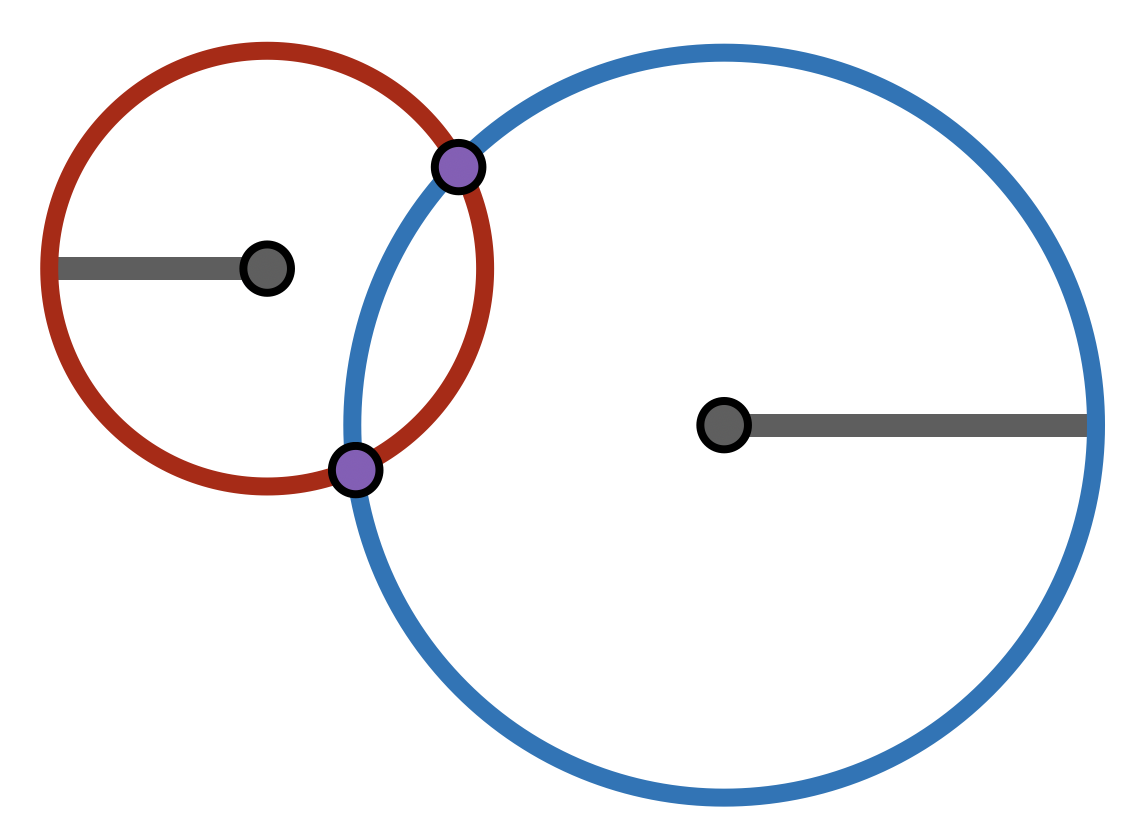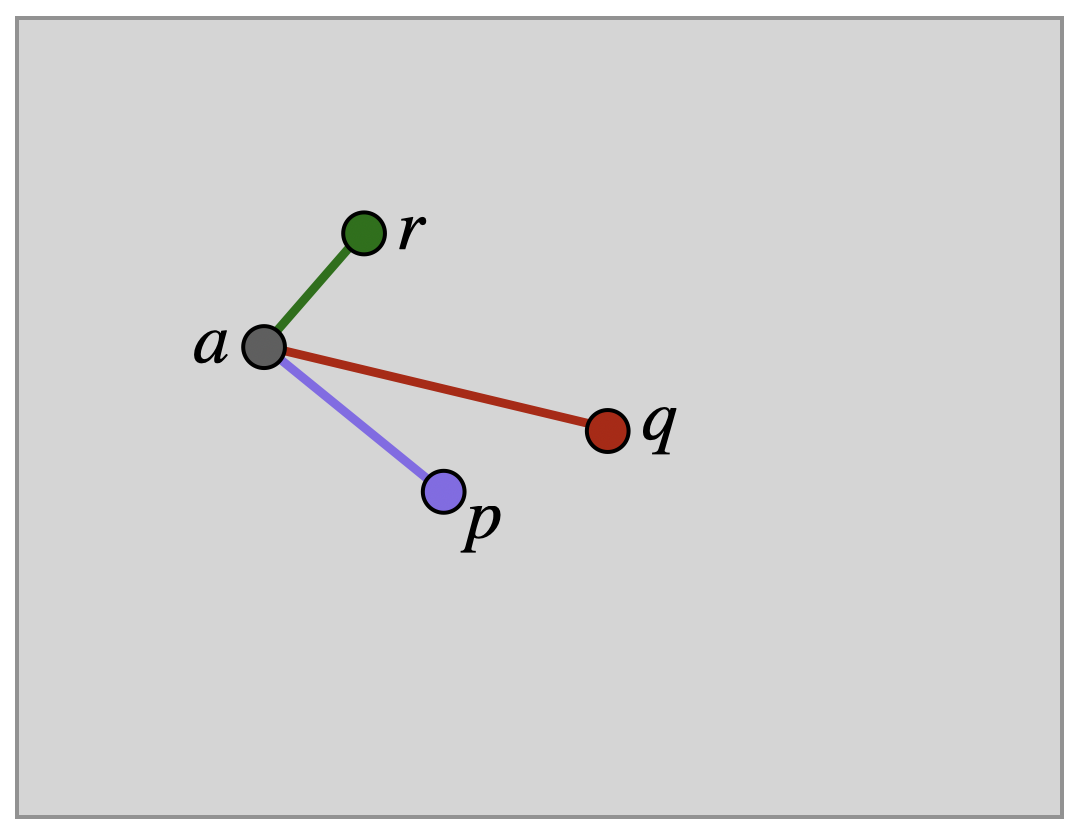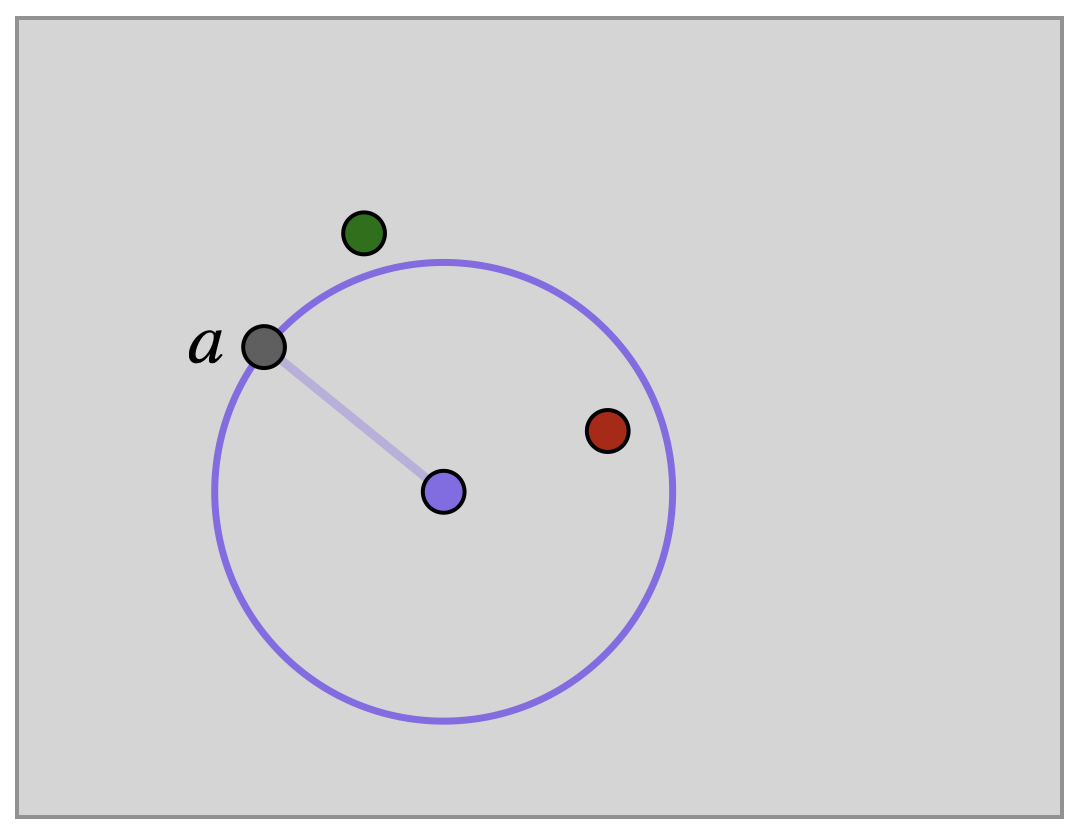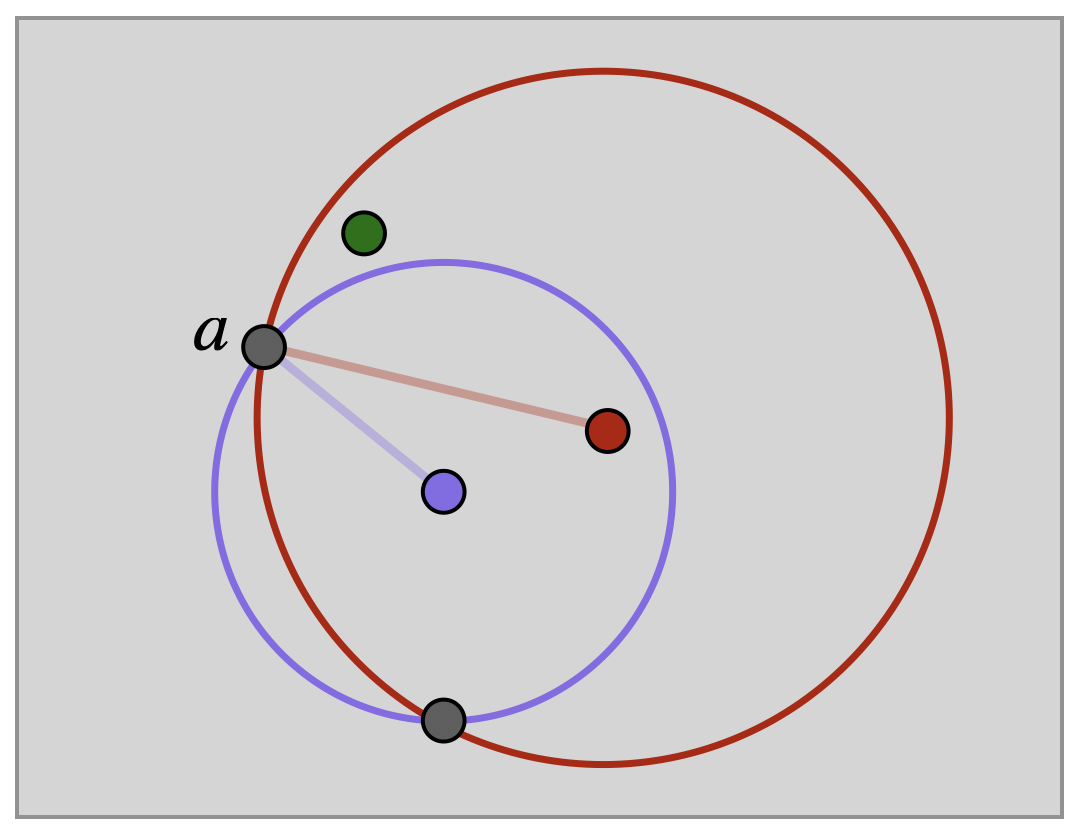13 Shapes
Defining the notion of lines and distance really helps in getting our new geometry off the ground. In this relatively short chapter, we give precise definitions for familar shapes: including polygons and cirlces, but also other conic sections - parabolas, ellipses, and hyperbolas known to the ancient Greeks.
13.1 Polygons
Definition 13.1 (Polygon) A polygonal chain is a sequence
A polygon is a closed, non-intersecting polygonal chain. The interior of a polygon is called a polygonal region.

A triangle is a polygon with three sides, a quadrilateral is a polygon with four sides, and so on. We will study polygons in more detail later on, especially in the curved geometries of the sphere and hyperbolic space. But for now, we content ourselves in getting used to the definitions by re-proving some familiar results of the greeks.
Exercise 13.1 (Constructing an Equilateral Triangle) Beginning with the segment
Exercise 13.2 (Equilaterals of Half the Size, Reprise) Re-prove that inside of an equilateral triangle, you can inscribe a smaller one with exactly half the side length. You already did this problem, using Euclid’s Axioms, but now we can do it much easier in our new foundations!
Hint: just find where the vertices should be, and then measure the distances between them!
13.2 Circles
Euclid’s definition of a circle is as follows: A circle is a plane figure bounded by one curved line, and such that all straight lines drawn from a certain point within it to the bounding line, are equal. In modern terminology, we may phrase this as below:

Definition 13.2 A circle centered at a point
Now that we know the distance function on
Theorem 13.1 The circle of radius
Proof. This is just a direct computation: if
Corollary 13.1 (Proving Euclid’s Axiom III) Given any point
Proof. Now that we have the actual equation for a circle, Euclid’s axiom is rather straightforwardly true. Saying we can draw a circle about any point of any radius is just asserting that the equation
One intuitive result about circles that we will use a lot in the near future is that any isometry of the plane that fixes the circles center must preserve the circle:
Proposition 13.1 (Isometries Fixing the Center Preserve the Circle) Let
Proof. Let

Exercise 13.3 Prove that applying any isometry or similarity to a circle results in another circle.
Computations
Recall that in all of Euclid’s axioms, conditions for intersections with circles were never specified! Indeed - Euclid intersected two circles in his construction of the equilateral triangle. Now that we have a precise description of circles in our new foundations, we can fix this gap:
Exercise 13.4 Prove that two circles intersect each other if the distance between their centers is less than or equal to the sum of their radii.
Hint: start by applying an isometry to move one of the circles to have center

The other case that is interesting but does not appear in Euclid is the intersection of a circle an a line.
'Exercise 13.5 (Circles Intersecting Lines) Prove that a circle intersects a line whenever the shortest distance from that line to the circles center is less than the circles’ radius.
Hint: start by applying an isometry that either (1) moves the line to the
13.3 Application: Classifying Isometries
The above exercises allowed us to compute exactly when two circles intersect - and crucially: how many times they do so. While our motivating reason to compute these things may have been to fill a gap in Euclid, this information can take us quite far when used correctly. Indeed, here we show that it is the key which allows us to classify all possible isometries of the plane!
We have discovered many isometries so far - translations, rotations (both about
One way to begin making progress on this question is to ask how much information do you need to completely determine an isometry? Is it possible that there could be two isometries that act like exactly the same function inside some region, but differ elsewhere? If so, that would mean it will be very hard to track down all isometries! But if not, we could ask ourselves what is the smallest region we need to understand an isometry on to specify it uniquely. And the answer is rather suprisingly minimal!
Proposition 13.2 (Isometries Fixing 3 Points) Let
Proof. Let

First, look at

As

However by Exercise 30, we know that generically circles will intersect in two points, so from the information we have so far, its not guaranteed that

Each pair of these circles intersects in two points. And, as the points are noncollinear, all three circles intersect in a single point (homework exercise, below). But this must be both
And
Remark 13.1. In special cases (when
Exercise 13.6 (Circle Triple Intersection) Three circles with non-collinear centers can intersect in at most one point.
Hint: use some isometries to simmplify the situation: move everything so that two of the circles center’s are on the
PICTUREs
Corollary 13.2 (Isometries Agreeing on 3 Points are Equal) If
Proof. Let
Using this, we can prove that we have actually found all the isometries, by starting from an arbitrary isometry and building it using only translations, rotations, and reflections.
Theorem 13.2 (Classification of Isometries) Every isometry of
Proof. Let

The isometry

Let

Since

There are only two such points in the plane, which lie at the intersections of the cirlces

Now, we have the map
One by one composing with the inverses of the maps we’ve added on, we can now solve for
Since the inverse of a translation is just another translation, the inverse of a rotation is another rotation, and the inverse of a reflection is another reflection (its the same reflection, actually!) we see
Thus - every isometry is built from the building blocks we already know of: there are no new mystery isometries out there to be discovered! This is a powerful fact as it lets us claim things about all isometries by just checking them with rotaitons, translations, and reflections. For example:
Corollary 13.3 (Isometries are Affine Maps) All Euclidean isometries are affine maps of the plane.
Proof. Let
Each of these components is an affine function, so the entire isometry
13.4 Conic Sections
Though greek geometry lacked the ability to deal with general curves, they did know quite a lot about a specific family of curves called conic sections These include the circles and lines we have already discussed, but also parabolas, ellipses, and hyperbolas. We will not spend much time on them here, except to show how our new formalism lets us come up with precise equations for these curves much as it did for lines and circles already.
Remark 13.2. These curves are called conic sections because we can alterantively define them as the possible curves one can get by slicing a 3-dimensional cone by a plane at different angles.
13.4.1 Parabolas
A geometric definition of the parabola dating back to ancient greece is that it is the set of points which lie at an equal distance from a given point and line in the plane. More precisely
Definition 13.3 Let
Recall that the distance to a line

Exercise 13.7 Let
Exercise 13.8 In this problem we confirm that
- Write down an algebraic equation for the coorddinates of a point
- Find which point
13.4.2 Ellipses & Hyperbolas
Ellipses and hyperbolas are also defined by a condition involving distance. Instead of distance from a single point (circles) or distances between a point and a line (parabolas), these shapes involve the distances from a pair of points.
Definition 13.4 Let

Exercise 13.9 Find an equation of the form
A hyperbola is defined similarly, except it is a difference of distances instead of a sum:
Definition 13.5 Let
This distance difference may be positive or negative (hence the absolute value). Each sign determines one branch of the hyperbola - its a disconnected curve with two components!

Exercise 13.10 Prove that the equation
13.4.3 Equidistants to a Line
This is not itself a conic section, but like the previous shapes we’ve discussed fits into the class of “shapes defined by a distance constraint.”” A circle is the set of points which are equidistant from a point (its center). One could attempt to generalize this notion by replacing the point at the center with something more general, and measuring
The most reasonable “generalized center” to consider first is a line: it is the only other shape we know so far, after all! What curves are equidistant to a line? In fact, the answer here is not that interesting: its just a pair of two lines.
Proposition 13.3 Given a line
Proof. Let
Thus, the set of points at distance
However, we include brief mention of this fact for two reasons. One, in a lost work of Archimedes, On Parallel Lines, it seems that he tried to work with alternative definitions of parallelism based on this fact, to simplify Euclids theory. Below is a quote from Boris Rosenfeld’s A History of Non-euclidean Geometry:
It seems that the first work devoted to this question [the theory of parallels] was Archimedes’ lost treatise On parallel lines which appeared a few decades after Euclid’s Elements. […] it is very likely that Archimedes used a definition of parallel lines different from Euclid’s. […] it is possible that Archimedes based his definition of parallel lines on distance.
And secondly, while we found here that the equidistant curves to a line are just another pair of lines, this fact (as presciently investigated by Archimedes) is actually equivalent to the parallel postulate, and so will be false in the other geometries we study! Thus, we will reference this short section in those future geometries, to contrast our new discoveries with the old.